Keywords
|
| Grid, sine wave inverter (SWI), photovoltaic (PV) array, total harmonic distortion (THD). |
INTRODUCTION
|
| Recently renewable energy power supplied into the utility grid has been paid much attention due to increase in fossil fuel prices, environmental pollution and energy demand boom. Among various renewable energy resources such as solar, wind, tidal, geothermal, biomass etc., the solar photovoltaic system being more attractive and promising green resource because of its abundant availability, safe resource, cost free and eco-friendly. The solar photovoltaic (PV) modules directly converts the light energy into the electrical energy, but energy obtained from the PV module acts as low voltage DC source and has relatively low conversion efficiency. In order to improve the efficiency and convert low voltage DC source into usable AC source, the power electronics converters are used to transform DC into AC. Conventional inverter topologies such as voltage source inverter (VSI) and the current source inverter (CSI) are being utilized to convert solar power generated electrical power into the utility grid. Whereas these topologies require additional DC/DC converter stage resulting in a two stage power conversion and also require interfacing transformer to inject power into the grid. These topologies not only increase the circuit complexity but also increase the cost and space requirements. |
| The single stage solar power conversion will satisfy all the control objectives like maximum power point tracking (MPPT), synchronization with grid voltage, and lower harmonic content in the output current. At present scenarios several solutions for a grid connected PV system with conventional two-level and multilevel inverter has been reported in the literature. |
| In case of two-level inverter, it inject maximum PV power into the grid with a unity power factor, however the system fails to be free from higher order harmonics, high voltage stress across the semiconductor power switch and high power losses due to high switching frequency [6]. In order to overcome the above mentioned problems, multilevel inverter came into picture and attracted more attention because of their significant properties. They offer lower total harmonic distortion (THD), low dv./dt device switch voltage stress, lowering the switch voltage and power rating etc. The multilevel inverter is well suited for high power medium voltage applications and in particular dominated by cascaded multilevel inverter and neutral point clamped multilevel inverter. In these medium voltage applications cascaded multilevel inverter and neutral point clamped multilevel inverter requires transformer to obtain electrical isolation between active DC sources of the H-bridge or NPC converter cells. This condition introduces losses, increases converter footprint, making converter costly, bulky and complex. The main drawback of the cascaded multilevel converter coupled with the transformer makes circulation current between phase during unbalanced network conditions and it may cause asymmetrical phase voltages. |
| The modular multilevel inverter has strong potential to replace cascaded multilevel converter in medium voltage applications. This paper, presents the design of a solar photovoltaic power conversion system with single stage sine wave inverter. Currently intensive research is going on in SWI and it has high potential for medium power applications. Sine wave inverters have several advantages over conventional multilevel topologies. Those significant are as follows. |
| • Generate low harmonic output voltage, this eliminates filtering requirements. |
| • For medium voltage application, it allows to avoid interfacing transformer. |
| • Modular structure allows extending higher number of levels easily. |
| • Capacitor voltage balancing is attainable independent of the load. |
| Although SWI are investigated with many applications, but it has not been reported in the literature with single stage solar PV power conversion system. This paper demonstrates the effective implementation of the photovoltaic supported SWI for grid interface which satisfy all the control objectives like maximum power transferring under varying environmental conditions, synchronizing grid utility voltage with output current for unity power factor operation and low total harmonic distortion. Section II gives introduction about basic characteristics of the photovoltaic module which is followed by section III that describes the proposed system and controller. Section IV discusses about designing of simulation and results followed by proposed method conclusion in Section V. |
OVERVIEW OF A PHOTOVOLTAIC (PV) MODULE
|
| To understand the PV module characteristics it is necessary to study about PV cell at first. A PV cell is the basic structural unit of the PV module that generates current carriers when sunlight falls on it. The power generated by these PV cell is very small. To increase the output power the PV cells are connected in series or parallel to form PV module. The electrical equivalent circuit of the PV cell is shown in Fig. 1. |
| The main characteristics equation of the PV module is given by [2] |
 |
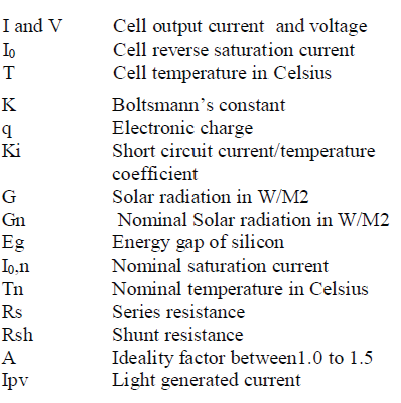 |
| The I-V characteristic of a PV module is highly non-linear in nature. This characterisitcs drastically changes with resepct to changes in the solar radiation and cell temperature.Whereas the solar radiation mainly affects the output current, the temperature affects the terminal voltage. Fig.2 shows the I-V characterisitcs of the PV module under varying solar radiations at contant cell temperature (T = 25 ºC). |
| Figure.3 shows the I-V characterisitcs of the PV module under varying cell temperature at contant solar radiation (1000 W/m2). |
| Figure.5 shows the three level configuration of the SWI, where two sub modules are connected in series on the upper arm and two sub modules are connected on the lower arm. Inductance Ula and Lla are used to take over the difference between the current of the upper and lower arm. Where as RL and LL are load resistance and load inductance of the SWI converter. Depending upon the voltage requirement the sub modules are inserted on the upper and lower arm. |
 |
PROPOSED SYSTEM AND ITS CONTROLLER
|
| In this section, the proposed topology of the photovoltaic supported sine wave inverter and its controller design with maximum power point tracking technique are described. The SWI proposed for a grid connected photovoltaic system is based on the single stage solar power conversion system. Fig.6 shows the photovoltaic supported sine wave inverter single phase grid connected system. The photovoltaic module is nonlinear in nature, because it is greatly affected by its environmental condition like change in solar radiation and cell temperature. During day time sunshine won’t be constant, cloud may pass over so panel may be not be getting constant radiations. Therefore it is necessary to track the maximum power all over the day. The maximum power point tracker works on the fact that derivation of the output power with respect to the panel voltage is equal to zero at maximum power point. Fig.7 depicts the P-V characteristics of PV module. |
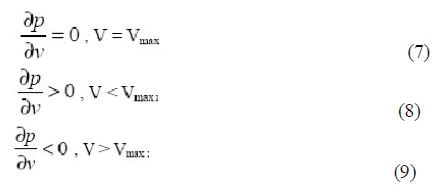 |
| The most popular and simple MPPT algorithm is the perturb & observe which is also called as hill-climbing algorithm. This technique employs simple feedback arrangement with the comparison of present and previous measured values. |
| Here, sine wave inverter is employed as a interconnecting medium between solar array and grid/load. It consists of Boost converter, Controlled rectifier and 3-Phase inverter. Output current from inverter is continuously monitored and modulated in controlled rectifier section while inverter voltage is made in phase with grid voltage by 3-Phase inverter ( Which in operated with voltage controlled mode). The proposed method is controlled by two control loops. |
| The inner current control loop and the outer voltage control loop. The inner current control loop is designed to control the grid current to be sinusoidal and synchronized with the grid voltage. In outer voltage control loop, the reference DC link voltage is generated by the MPPT algorithm; it sensed IPV and VPV and then generates Vmax. This Vmax is DC link voltage required to be regulated across the SWI. The error resulting from the DC voltage control loop is passed through the proportional plus integral (PI) controller. |
SIMULATION RESULTS AND DISCUSSIONS
|
| The proposed sine wave inverter for grid connected PV system with single stage power conversion is simulated with MATLAB /SIMULINK. The photovoltaic array is composed of 108 number of cells connected in series to form a module and 14 modules connected is series to generate voltage of 1200 V. The circuit parameters are shown in the Table.II. |
| The system is simulated using the solar array with the MPPT technique and the system is connected to the grid and phase sequence of the PV system and grid are matched. The frequency of the solar system output is matched with the grid frequency by taking reference of current from the grid. |
| The MPPT algorithm is developed in the MATLAB /SIMULINK environment and is shown in the fig. 4. The perturb and observe algorithm technique is used in the MPPT controller block. Figure .6. shows the model of the solar array considering the temperature and irradiance of the system. |
| The current of the PV system and the grid are analyzed and the output is shown in fig. 7. The voltage developed by the PV system and the grid are shown in Fig.8. |
CONCLUSION
|
| In this paper, sine wave inverter based grid connected photovoltaic system is proposed. The pi concept allows the application to be extended for wide power range. This study makes an attempt and verifies that the SWI system is capable of injecting power into the grid with low total harmonic distortion, unity power factor and high efficiency. Conventional multilevel converter requires interfacing transformer for grid connected system applications, whereas SWI topology requires filter to connect inverter into the grid. Low switching frequency of the switches in the SWI leads to low power loss. The effectiveness of the proposed grid connected SWI single stage power converter is demonstrated through simulation studies. |
Tables at a glance
|
 |
 |
| Table 1 |
Table 2 |
|
Figures at a glance
|
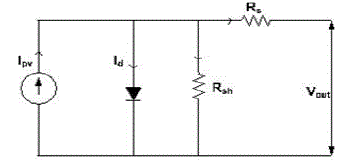 |
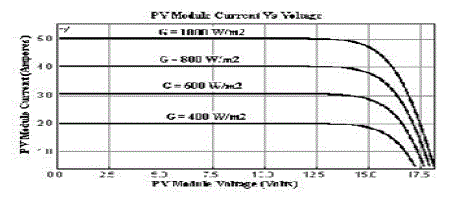 |
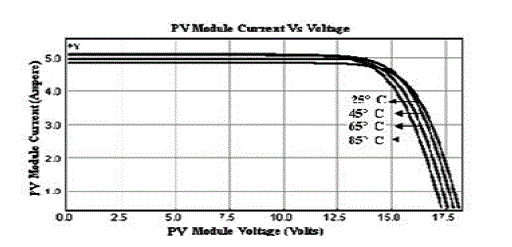 |
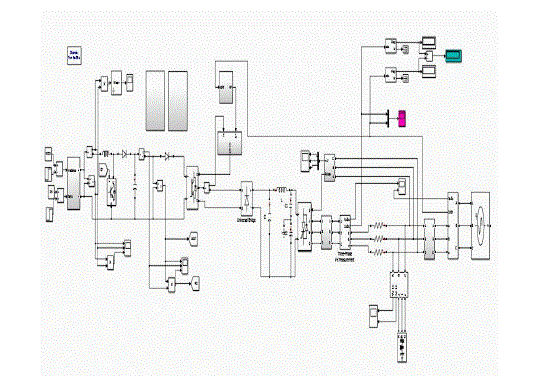 |
| Figure 1 |
Figure 2 |
Figure 3 |
Figure 4 |
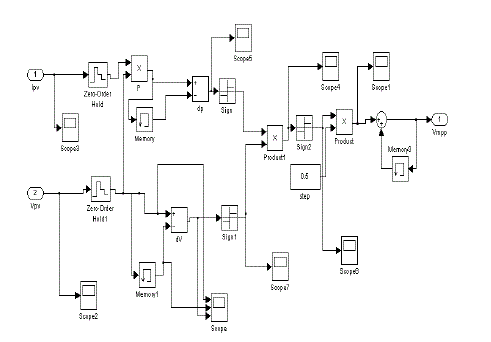 |
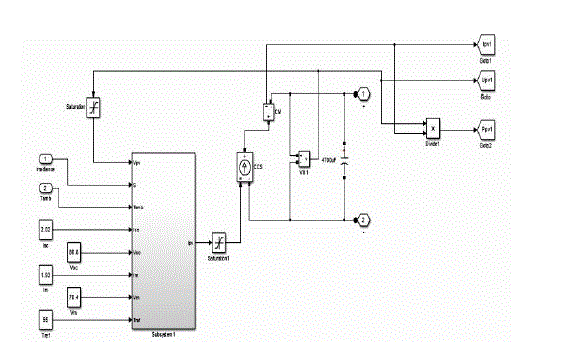 |
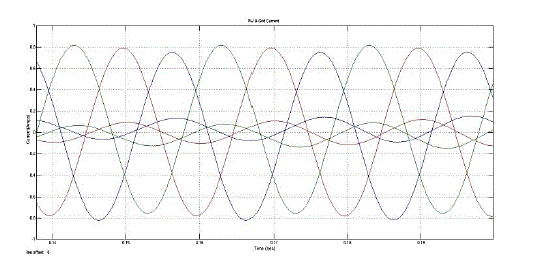 |
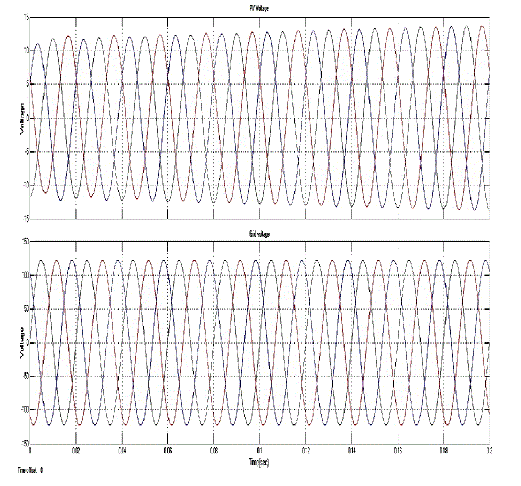 |
| Figure 5 |
Figure 6 |
Figure 7 |
Figure 8 |
|
References
|
- J. T. Bialasiewicz, "Renewable Energy Systems with Photovoltaic Power Generators: Operation and Modeling," IEEE Tran. Ind. Electron.vol. 55, pp. 2752-2758, 2008.
- M. G. Villalva, et al., "Comprehensive Approach to Modeling and Simulation of Photovoltaic Arrays," IEEE Transactions on powerelectronics, vol. 24, pp. 1198-1208, 2009.
- J.A. Gow, C. Manning, "Development of a photovoltaic array model for use in power-electronics simulation studies," in proc. IEE Electricpower applications, vol 146, issue 2, pp.193-200, March 1999.
- S. B. Kjaer, J. K. Pedersen, and F. Blaabjerg, “A review of single-phase grid-connected inverters for photovoltaic modules,” IEEE Trans.Ind. Appl., vol. 41, no. 5, pp. 1292–1306, Sep./Oct. 2005
- L G. Leslie, “Design and analysis of a grid connected photovoltaic generation system with active filtering function” Master of Science inElectrical Engineering Blacksburg, Virginia March 14, 2003.
- 6 M Malinowkski, K.Gopakumar, J Rodriguez and M A.Perez “A survey on cascaded multilevel inverters”, IEEE Trans on Indus. Electronics,Vol.57, No7, pp.2197-2205, July-2010.
- R. Gupta, A. Ghosh and A. Joshi, “Cascaded multilevel control of DSTATCOM using multiband hysteresis modulation”, IEEE Power Eng.Soc. General Meeting, pp.18–22, Jun. 2006.
- 8 G. Vachtsevanos and K. Kalaitzakis, “A hybrid photovoltaic simulator for utility interactive studies,” IEEE Trans. Energy Conv., vol. EC-2,pp. 227–231, June 1987.
- M. G. Jaboori, M. M. Saied, and A. A. Hanafy, “A contribution to the simulation and design optimization of photovoltaic systems,” IEEETrans. Energy Conv., vol. 6, pp. 401–406, Sept. 1991
- G. P. Adam, O. Anaya, G. Burt, D. Telford, B. Williams and J. McDonald, "Modular multilevel inverter: Pulse width modulation andcapacitor balancing technique," IET Power Electronics, vol. 3, pp. 702- 715, 2010.
- R. Gupta, A. Ghosh and A. Joshi, “Control of 3-level shunt active power filter using harmonic selective controller”, Proc. IEEE Power IndiaConference, pp. 10-15. April 2006.
- M. Glinka, ‘‘Prototype of multiphase modular-multilevel-converter with 2MWpower rating and 17-level-output-voltage,’’ in Conf. Rec.IEEE PESC, 2004, pp. 2572--2576.
- S. Allebrod, R. Hamerski, and R. Marquardt, ‘‘New transformerless, scalable sinewave inverters for HVDC-transmission,’’ in Conf.Rec.IEEE PESC, 2008, pp. 174--179.
- R.Gupta, G.Gupta, D.Kastwar, A.Hussain, H. Ranjan, “ Modeling and Design of MPPT Controller for a PV Module usingPSCAD/EMTDC” in IEEE Power Energy Society conference, pp. 1-6, Oct. 2010.
- F. Blaabjerg, et al., "Overview of Control and Grid Synchronization for Distributed Power Generation Systems," IEEE TransactionsIndustrial Electronics, on, vol. 53, pp. 1398-1409, 2006.
- R. Gupta, A. Ghosh and A. Joshi, “Multi-band hysteresis modulation and switching characterization for sliding mode controlled cascadedmultilevel inverter”, IEEE Trans. Ind. Electron., vol. 57, no.7, July 2010.
|